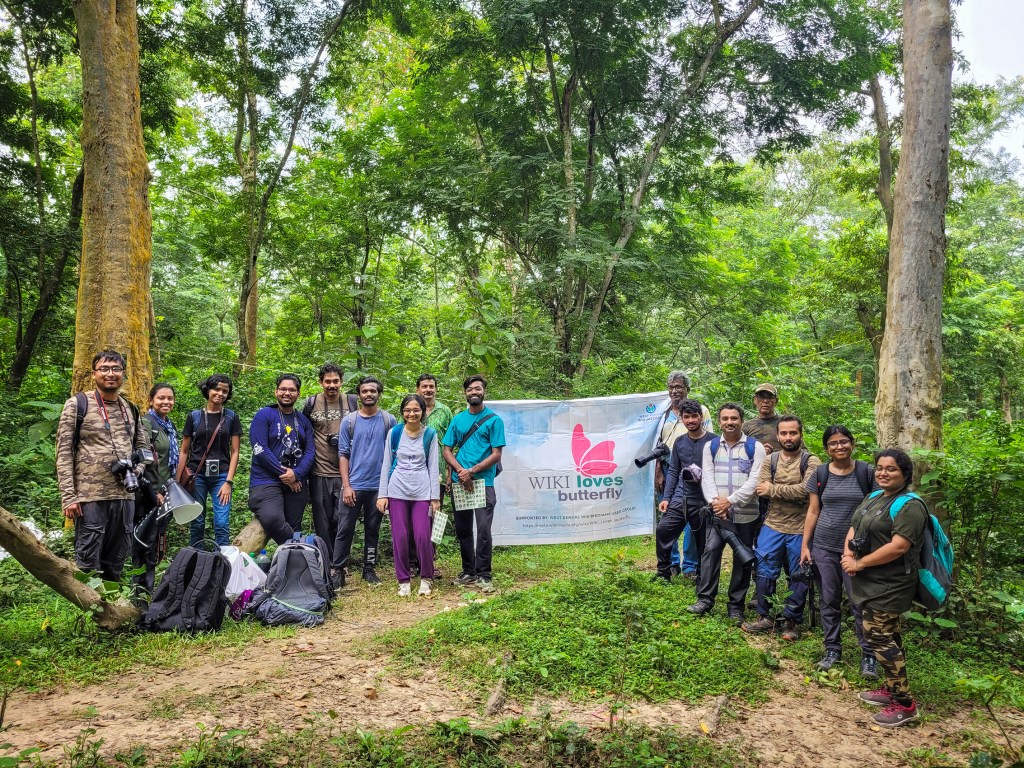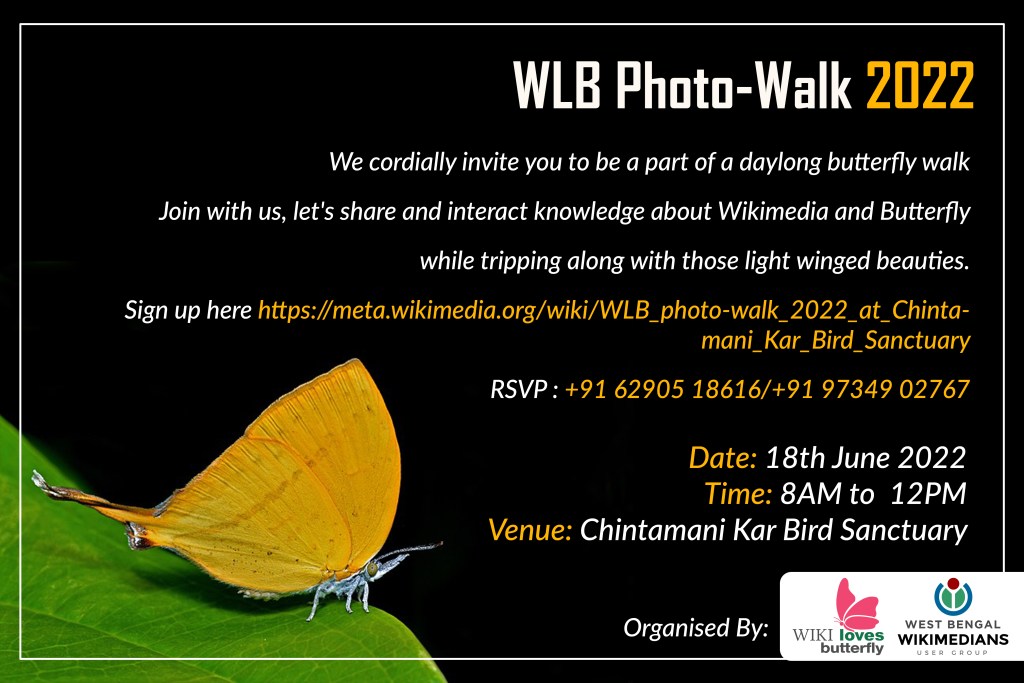A nature photo-walk rejuvenates you by clearing your mind from the stress and strain of your busy life, intricately connecting you with the refreshing colors and soothing sounds and strengthening your bonding with Mother Nature while giving you first hand information and knowledge about the flora and fauna of the surroundings. A butterfly photo-walk serves all the same with special emphasis only to these flying beauties.
Unlike expeditions and exploratory field trips, photo-walks are organized as small and budget-friendly trips meant for interested first-timers or people with little experience on the subject, which helps them to gain experience by interacting with and observing the more experienced members of the group.
There are few important things to consider before organizing a butterfly photo-walk.
Look for appropriate hot-spots:
Always look for a safe and well-communicated location with a good prospect for photography. A pre-visit of the location is of great importance to have all the related information ready in mind like accessibility, permission from authority, terms and conditions, entry fee, local transport and eateries, nature of local people, any possibility of local disturbance or hooliganism etc.
Such a venue could be of a wide range from urban nature parks or botanical gardens or or sacred groves with vegetation or local forests to wildlife sanctuaries or reserve forests. It should be conveniently traveled with a 1-2 hours journey to save time and energy of the participants. A safe drinking water source is a must and eateries in proximity can be a plus point.
Fix a date and check the weather:
This is of immense importance in butterfly photo-walks as activities of butterflies are highly affected by weather. For a good prospect a bright sunny, hot and humid day is the best pick. Cold weather and winter season should be excluded as butterflies are least active at that time.
Check for weather updates from reliable weather forecast sites or weather news from television or radio programs to ensure a bright sunny day of 25-28° centigrade temperature which excites butterflies to frisk, dart, hover, puddle, busk, nectar and so on.
Plan your route:
Plan your route in advance to efficiently use the time for photography. As a photo-walk organizer or coordinator, you should always be helpful to other participants to share all possible information on how they can travel and reach the venue and assemble at a pre-destined spot before time from where the entire team will move together.
Know the rules and regulations of your venue:
The photo-walk organizers should have clear knowledge of the rules and regulations as well as the dos and don’ts of the prospective venue and intimate all the participants verbally as well as through pamphlets or cheat sheets before and during the walk. This can avoid untoward incidents and ensure a healthy environment. It is a must to check for any permissions required and to collect them for all participants from concerned forest department officials in case you are planning to venture into wildlife sanctuaries or reserve forests.
Spread the news:
The photo-walk event should be well advertised and propagated in social media for interested persons to know. It should be highlighted what new learnings can the participants take away from the walk. There needs to be a way to register the participants where they can share contact information, which can help you contact them to ensure their participation, arrange for logistics and share necessary information. It is of utmost importance to limit participation as per your capacity as too much crowd can bring nuisance in the wild frightening the butterflies.
This is a Social media banner for Wiki Loves Butterfly Photo-Walk 2022 at Chintamani Kar Bird Sanctuary.
(Souradipta Saha CC BY-SA 4.0)
Bring experience:
Presence of lepidopterists, experienced butterfly photographers or resource persons into your team shall be of immense value to the event as they can help, guide and mentor relatively new butterfly enthusiasts answering their queries about species identification, behavioral patterns, host plants, life cycles etc. Keeping some copies of field guide booklets can increase the value too.
Prepare a smart schedule:
A smart and interesting schedule of the event must be prepared beforehand to ensure utilizing proper time span for each program. It can be like this-
- Gather in a specific meeting point.
- Brief self-introduction of all participants including the organizers
- General briefing about the purpose of the butterfly photo-walk
- Expert’s briefing about the world of butterfly
- Exploration and photography in action
- Recess
- Identification of butterfly species and preparing a checklist
- Question and answer session with expert
- Group photos with event banner (if any) or with forest or nature park signboard at the entry gate.
Carry photographic gears:
- Camera and accessories: It is always better to carry a macro facilitated digital camera, preferably DSLR with intermediate macro lenses (90mm-105mm) or long macro lenses (150mm-200mm) or telephoto zoom lenses (55-200mm, 55-250mm, 70-300mm, 75-300mm, 70-350mm etc.) with flash gun, diffuser. For more quick tips on using them, read this Diff post.
- Mobile camera: If any participant does not have any camera, please remember, a smartphone is not great in low light situations. It’s best to capitalize on lighting conditions under which your device best functions. Do not ever use the zoom on your smartphone as the images come out grainy or hazy. Instead, move closer to the subject as much as possible so that you don’t have to rely on the camera. Always try to clean the glass of the lens to avoid a greasy thumbprint.
- Enough memory cards and always try to carry spare batteries if possible.

(Sandip Das CC BY-SA 4.0)
Dress for the butterflies:
It is better to avoid bright coloured dresses to avoid unwanted attention. Use a camouflage or dark coloured dress instead. A full-sleeved dress prevents irritation caused by wild weeds and poisonous plants. Waterproof trek shoes with good grip covering your entire feet and guarding your ankles are highly advisable. During monsoon months, snake bite protection leggings or gaiters are very essential especially in forests.
Bring back memories and photographs, leave only your footprints:
It is extremely important to preserve the environment for the butterflies as it is. The participants should be informed to bring metal water bottles to avoid littering disposable plastic bottles. Participants should be strictly instructed to not litter plastic wrappers of food, chocolates etc and to bring them back to dispose of them in appropriate places. Perfumes, deodorants, hairsprays etc. should be avoided because their strong scent destroys the natural fragrances. Making noise during the photographic activity can frighten the wild habitats of the area including the butterflies and break the silence of the environment, which should be avoided at any cost.
Last but not certainly least, and this goes without saying for all participants, respect the nature you photograph. If all photographers practice leaving no trace principles and leave places better than they found them, it will insure these locations and the wildlife that live in them can be preserved for years to come.

(Manaska Mukhopadhyay CC BY-SA 4.0)

Can you help us translate this article?
In order for this article to reach as many people as possible we would like your help. Can you translate this article to get the message out?
Start translation
